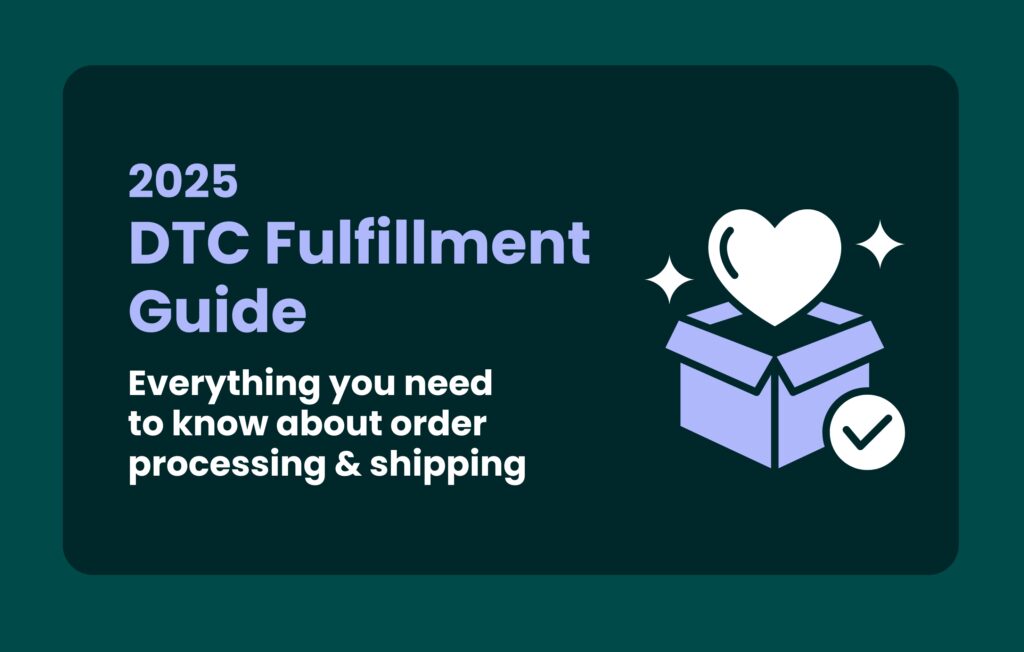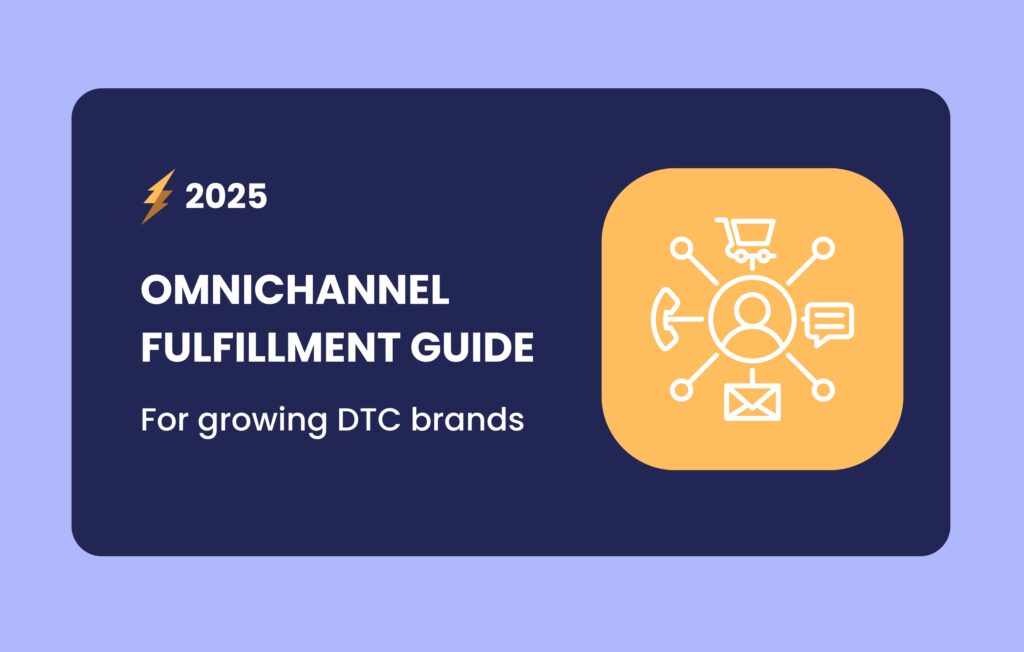Your warehouse looked fine when you were shipping 50 orders a day. Now you’re pushing 500, and suddenly everything’s on fire. Your team spends half their time hunting down misplaced inventory, carrier rates jumped again last quarter, and customers expect two-day shipping like it’s a human right.
Welcome to direct-to-consumer fulfillment at scale. It’s messy, expensive, and unforgiving when you get it wrong.
Most DTC brands hit a wall somewhere between in-house chaos and writing a check to a 3PL they don’t fully trust. You’re stuck wondering if you should build better systems, hire more people, or hand the whole operation to someone else.
This guide cuts through that confusion. We’ll walk through how modern DTC fulfillment actually works, what it costs, when to outsource, and how to stop bleeding margin on shipping. No fluff, just the framework you need to make a decision.
TL;DR
- DTC fulfillment covers receiving, storing, picking, packing, shipping, and returns-not just putting boxes in trucks.
- Stay in-house until 1,000-1,500 monthly orders. Above 5,000 orders, you need 3PL help or multiple warehouse locations.
- Your 3PL should sync inventory in real-time with your store. Excel file updates mean their tech is broken.
- Rate shopping across carriers saves 15-30% per package. Regional carriers beat major names on nearby zones.
- Barcode scanning drops pick-and-pack errors below 1%. Paper lists run 3-5% error rates that cost you double.
- Negotiate carrier discounts once you ship 1,000+ packages monthly. Rates climb 5-7% every year otherwise.
- Hire temporary staff 4-6 weeks before Q4. Peak season volume can triple your baseline overnight.
Before you can fix your fulfillment problem, you need to know what you’re dealing with. Most people use “DTC fulfillment” and “shipping” interchangeably, but they’re different animals.
Table of Contents
What is DTC Fulfillment and Why It Matters
Defining Direct-to-Consumer Fulfillment
DTC fulfillment is the entire process of getting products from your warehouse to individual customers’ doorsteps. It covers receiving inventory, storing it, picking and packing orders, shipping them out, and handling returns. Unlike B2B fulfillment (where you ship pallets to retailers), you’re dealing with individual orders going to thousands of different addresses.
The complexity compounds fast. Each order needs its own box, label, and carrier selection. You’re managing multiple SKUs, dealing with gift messages, and coordinating with various shipping carriers who all have different pricing structures.
The Business Impact of Fulfillment Strategy
Your fulfillment operation directly affects your bottom line in three ways: cost structure, customer experience, and operational capacity. Get it wrong and you’re bleeding money on inefficient picking routes, paying premium shipping rates, and losing customers to slow delivery. Get it right and fulfillment becomes a competitive advantage that lets you scale without drowning in logistics headaches.
Think of fulfillment like a factory assembly line. If one station breaks down, the whole operation grinds to a halt. Understanding each component helps you spot where things are going sideways before they tank your margins.
Core Components of DTC Fulfillment Operations
Receiving and Inventory Management
This is where products arrive at your warehouse and get logged into your system. You’re tracking SKUs, quantities, and locations so you actually know what you have and where it lives. Good inventory management means real-time visibility and accurate counts. Bad inventory management means overselling products you don’t have and apologizing to angry customers.
Order Processing: Pick, Pack, and Ship
When an order comes in, someone walks the warehouse floor to pick the right products, pack them securely with appropriate materials, and slap on a shipping label. This is where speed and accuracy either make or break your customer experience. A mis-picked order costs you twice-once to ship the wrong item, again to fix it.
Shipping and Carrier Management
You’re choosing carriers, negotiating rates, and managing delivery timelines. USPS might work for lightweight items, while FedEx handles your bulkier shipments. Rate shopping across carriers can save 15-30% per package, but only if you have the systems to compare in real-time.
The choice between in-house, outsourced, or hybrid fulfillment isn’t about what’s best in theory. It’s about what works for your volume, margins, and team capacity right now.
How to Choose Your DTC Fulfillment Model
In-House vs. 3PL vs. Hybrid Models
In-house fulfillment means you own the warehouse, hire the staff, and control everything. You’ll keep margins tighter and maintain quality control, but you’re stuck with fixed costs whether you ship 100 orders or 10,000.
Third-party logistics (3PL) partners handle everything for you. They charge per order, which scales with your volume, but you’re giving up control and paying a premium for their infrastructure.
Hybrid models split the difference. You might handle local orders in-house while a 3PL covers other regions, or keep high-margin products internal and outsource the rest.
Decision Criteria and Volume Thresholds
Most brands stay in-house until they hit 1,000-1,500 orders monthly. Below that, 3PL fees eat too much margin. Above 5,000 orders, you need serious warehouse infrastructure or multiple 3PL locations to maintain speed.
Consider your growth trajectory, not just current volume. If you’re doubling year-over-year, building in-house capacity becomes a constant chase. Factor in your team’s bandwidth too-fulfillment operations pull focus from product development and marketing.
Most 3PLs have polished sales decks and promise the world. Three months later, you’re dealing with inventory black holes and support tickets that go nowhere. The trick is knowing what questions separate the competent from the catastrophic.
Evaluating 3PL Fulfillment Partners
Technology Integration and Visibility
Your 3PL should integrate directly with your e-commerce platform without requiring a developer. Look for real-time inventory syncing and order status updates that feed back to your store automatically. If they’re still sending Excel files for inventory reports, run.
Operational Capabilities and Network
Check their warehouse locations against your customer distribution. A single East Coast warehouse won’t help you hit two-day delivery for West Coast customers. Ask about their peak season capacity and what happens when your volume spikes 300% during Black Friday. Their answer should include specific numbers, not vague reassurances.
Cost Structure Transparency
Get a complete fee breakdown upfront. Storage fees, pick and pack rates, receiving charges, special handling costs-all of it. Watch for partners who quote low base rates but bury you in surcharges later. Request sample invoices from current clients if possible.
Most DTC brands face the same three fulfillment issues. They just don’t realize how much each one is costing them until they run the actual numbers.
Common DTC Fulfillment Challenges and Solutions
Managing Shipping Cost Volatility
Carrier rates jump 5-7% annually, and dimensional weight pricing punishes lightweight, bulky products. Negotiate volume discounts once you’re shipping 1,000+ packages monthly, and use multi-carrier strategies to compare rates per shipment. Regional carriers often beat FedEx and UPS on zones 2-4.
Handling Peak Season and Returns
Q4 order volume can triple your baseline, and returns spike post-holiday. Hire temporary staff 4-6 weeks before peak season starts. Set clear return windows and automate restocking workflows to get inventory back on shelves faster. Returns processing shouldn’t take more than 48 hours.
Maintaining Fulfillment Accuracy
Pick-and-pack errors cost you twice: the original shipment and the replacement. Barcode scanning reduces errors to under 1%. If you’re still using paper pick lists, you’re probably running 3-5% error rates without realizing it.
FAQ
📈 At what order volume should I switch from in-house fulfillment to a 3PL?
Most brands stay in-house until they hit 1,000-1,500 orders monthly. Below that threshold, 3PL fees eat too much margin to justify the cost. Once you’re consistently above 5,000 orders per month, you’ll need serious warehouse infrastructure or multiple 3PL locations to maintain delivery speed, which makes outsourcing more attractive.
📉 How can I reduce shipping costs without slowing down delivery times?
Negotiate volume discounts once you’re shipping 1,000+ packages monthly, and set up multi-carrier rate shopping to compare costs per shipment in real-time. Regional carriers often beat FedEx and UPS on shorter distances (zones 2-4), which can save 15-30% per package. Your 3PL or shipping software should handle this comparison automatically.
⚠️ What's an acceptable error rate for pick-and-pack operations?
You should aim for under 1% error rates, which is achievable with barcode scanning systems. If you’re using paper pick lists, you’re probably running 3-5% error rates without realizing it. Each mistake costs you twice-once for the wrong shipment and again to send the replacement-so accuracy directly impacts your margins.
📝 What should I look for when evaluating a 3PL partner?
Check that they integrate directly with your e-commerce platform without needing a developer, and confirm they provide real-time inventory syncing. Compare their warehouse locations against where your customers live-a single East Coast facility won’t get you two-day delivery on the West Coast. Get a complete fee breakdown upfront, including storage, pick and pack, receiving charges, and special handling costs, because some partners quote low base rates then bury you in surcharges.
📊 How do I prepare for peak season order volume spikes?
Hire temporary staff 4-6 weeks before peak season starts, not when you’re already slammed. Your Q4 volume can triple your baseline, so plan capacity accordingly. Set clear return windows and automate restocking workflows so returns don’t pile up-your returns processing shouldn’t take more than 48 hours to get inventory back on shelves.
The Bottom Line
DTC fulfillment stops being manageable right around 1,000-1,500 monthly orders. Below that threshold, keep operations in-house and focus on building clean processes. Above it, you need either serious warehouse infrastructure or a 3PL partner who won’t destroy your margins with hidden fees.
Here’s what you should do next:
- Calculate your true cost per order including labor, materials, and shipping-most brands underestimate by 30-40%
- If you’re approaching 1,500 monthly orders, request detailed pricing from three 3PLs and compare their full fee structures, not just base rates
- Implement barcode scanning if you’re still using paper pick lists-it pays for itself within 90 days through error reduction
- Negotiate carrier contracts once you hit 1,000 packages monthly, and set up rate shopping between at least two carriers
The brands that win on fulfillment aren’t the ones with the fanciest warehouses or the biggest 3PL contracts. They’re the ones who know their numbers, make decisions based on real volume data, and fix problems before they compound into margin killers.







